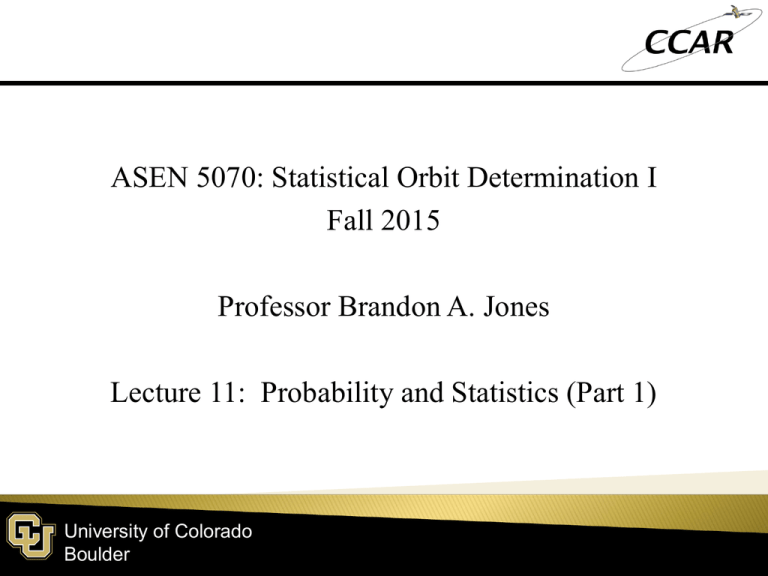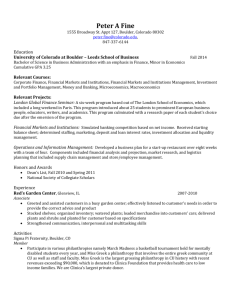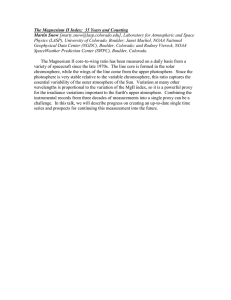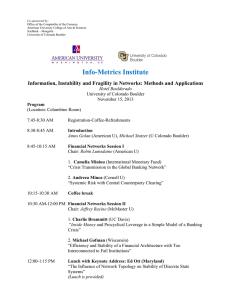ASEN 5070: Statistical Orbit Determination I Fall 2015 Professor Brandon A. Jones
advertisement

ASEN 5070: Statistical Orbit Determination I Fall 2015 Professor Brandon A. Jones Lecture 11: Probability and Statistics (Part 1) University of Colorado Boulder Lecture Quiz 4 Due Friday @ 5pm ◦ Due by 5pm on Friday Homework 4 Due September 25 ◦ As mentioned in e-mail, it is different from one originally posted at the start of the semester Final Make-up Lecture Today @ 4pm University of Colorado Boulder 2 Axioms of Probability Probability Distributions Multivariate Distributions University of Colorado Boulder 3 Axioms of Probability University of Colorado Boulder 4 X is a random variable (RV) with a prescribed domain. x is a realization of that variable. Example: ◦ 0<X<1 ◦ ◦ ◦ ◦ x1 = 0.232 x2 = 0.854 x3 = 0.055 etc University of Colorado Boulder 5 The conceptual definition holds for a discrete distribution Requires more mathematical rigor for a continuous distribution (more later) University of Colorado Boulder 6 Probability of some event A occurring: Probability of events A and B occurring: Axioms: University of Colorado Boulder 7 University of Colorado Boulder 8 Although we often see a probability written as a percentage, a true mathematical probability is a likelihood ratio University of Colorado Boulder 9 Mathematical definition of conditional prob.: Example: University of Colorado Boulder 10 Two events are independent iff Why is the latter true if A and B are independent? University of Colorado Boulder 11 Probability Distributions University of Colorado Boulder 12 Random variables are either: ◦ Discrete (exact values in a specified list) ◦ Continuous (any value in interval or intervals) Examples of each: ◦ Discrete: ◦ Continuous: University of Colorado Boulder 13 DRVs provide an easier entry to probability They are vary important to many aerospace processes! However, StatOD tends to deal more with CRVs We will primarily discuss the latter! ◦ Rarely discretize the system of coordinates University of Colorado Boulder 14 Probability of X in [x,x+dx]: where f(x) is the probability density function (PDF) For CRVs, the probability axioms become: University of Colorado Boulder 15 Using axiom 2 as a guide, how would we derive k in the following: University of Colorado Boulder 16 For the cases X ≤ x, let F(x) be the cumulative It then follows that: distribution function (CDF) ?? ? University of Colorado Boulder 17 • From the definition of the density and distribution functions we have: • From axioms 1 and 2, we find: University of Colorado Boulder 18 Multivariate Distributions University of Colorado Boulder 19 The PDF for two RVs may be written as: Hence, for two RVs: University of Colorado Boulder 20 How do we compute probabilities given a multivariate PDF? University of Colorado Boulder 21 We often want to examine probability behavior of one variable when given a multivariate distribution, i.e., Marginal density fcn of X University of Colorado Boulder 22 What would be the marginal probability density function of Y? University of Colorado Boulder 23 What if I only care about the probability of one variable? Alternatively, University of Colorado Boulder 24 Analogous to definition previously discussed, but rooted in the PDFs and marginal distributions University of Colorado Boulder 25 If X and Y are independent, then ??? University of Colorado Boulder 26


